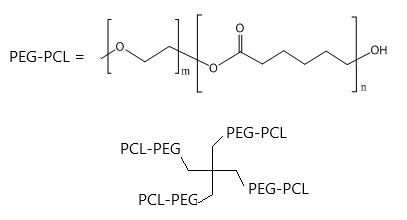Description
4-Arm PEG-PCL has one PCL block on each of the four PEG arms. The MW of PEG or PCL refers to the total MW of all four arms. PEG-PCL is an AB diblock copolymer consisting of a hydrophilic block polyethylene glycol (PEG) and a hydrophobic block polycaprolactone (PCL). Biocompatible PEGylated copolymers with biodegradable polyester used to prepare core-shell micelles, nanoparticles and microspheres. The hydrolytic degradability of polyester block depends on molecular weight and the spacer between ester (lactide, glycotide or caprolactone). PEG-PCL with other MWs is also offered.
Properties
Molecular weight: 4-Arm PEG MW refers to the MW of the entire PEG molecule. The MW of each arm is 1/4 of the MW indicated in the product name. MW of PEG was measured by MALDI-MS or GPC. PDI (polydispersity index) of our 4-Arm PEG is 1.02-1.05 with very narrow MW distribution. The number of repeating ethylene oxide units (CH2CH2O) or the degree of polymerization is calculated dividing the PEG MW by 44 (44 is the molecular mass of one repeating unit). Similarly the indicated ME of PCL is also for all PCL blocks.
Solubility: Soluble in chloroform, methylene chloride, DMF, DMSO, and less soluble in alcohol, toluene. Not soluble in ether. Its water solubility depends on the ratio of PEG to PCL content.
Physical form: PEG products generally appear as white or off-white powder, and for very low MW 4-Arm PEG such as MW 2k, it may appear as wax-like, semi-solid material due to the low MW and the type of functional groups.
Storage condition: PEG product shall be stored in the original form as received in a freezer at -20C or lower for long term storage. Stock solution of PEG reagents that do not contain oxygen or moisture sensitive functional groups may be temporarily stored in a refrigerator or ambient temperature for multiple days. Stock solution should avoid repeated freeze-and-thaw cycles. See Documents section for detailed storage and handling conditions.
References
1) Site-Specific Addressing of Particles and Coatings via Enzyme-Mediated Destabilization, Catalysts 2019, 9, 354; doi:10.3390/catal9040354
2) Biodegradable long-circulating polymeric nanospheres. Science 1994;363:1600, Text.
Click here to view an expanded list of hundreds of publications citing Creative PEGWorks products.


